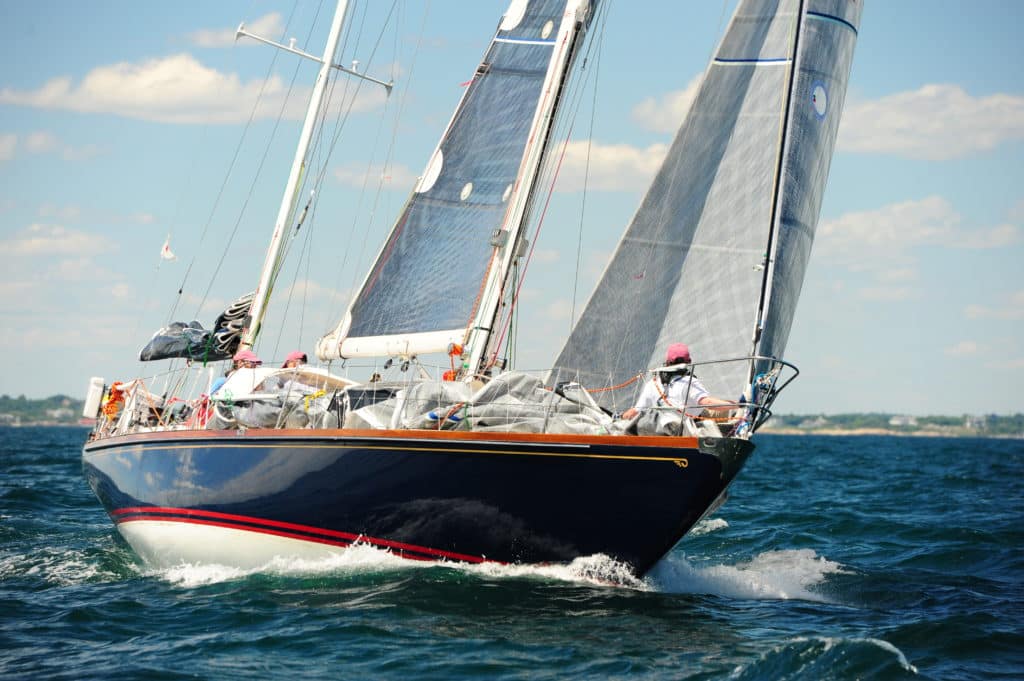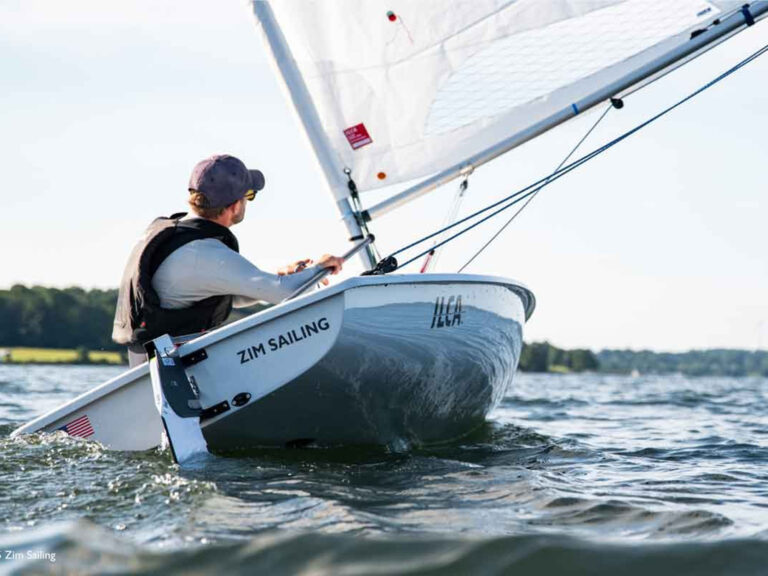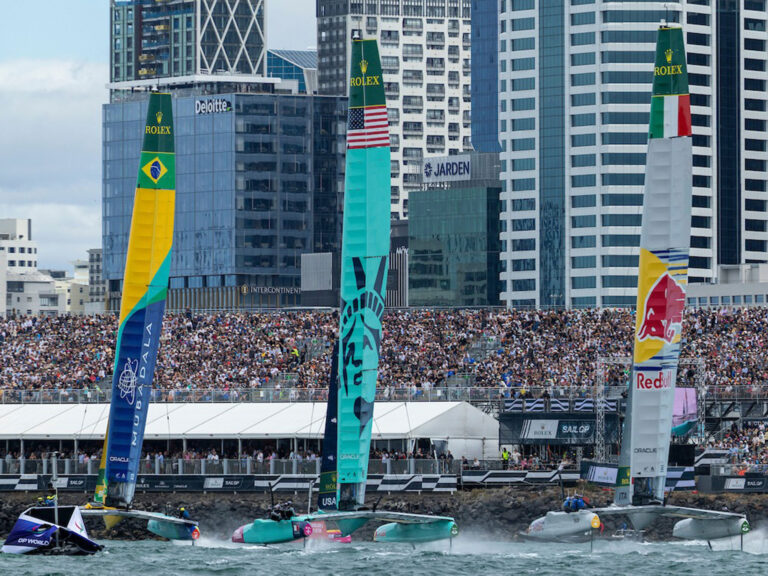Eighteen years ago, if you had told Mike and Connie Cone that they would win the 2014 Newport Bermuda Race St. David’s Lighthouse Division, they probably wouldn’t have believed you. In 1996, their Bermuda 40 Actaea finished dead last and the Cones were ready to throw in the towel. Instead, they decided to buckle down and began to make improvements that ultimately led to their win nearly two decades later. SAILING WORLD caught up with Mike and Connie to talk about their sought-after victory.
Over the last 10 races, what have you done in terms of the boat, crew, and strategy that has lead to this win?
MC: We’ve done so much-since 2001, we’ve reshaped the keel, redistributed the ballast. We modified the centerboard and trunk, as well as the rudder. The original Bermuda 40 rudder wasn’t shaped well, and does not come all the way up to the underside of the hull. It sticks out straight, the way that most old boats do. If you look at old photos of Actaea you see a jet of water shooting up from the stern through the gap, and that’s wasted energy. Yard workers spent hours reshaping the rudder, which now sits against the hull.
We made numerous other interior modifications to move weight, including moving the batteries; they’re now down against the hull almost at the level of the cabin sole. We went from three to two water tanks, and put in a water maker instead. On deck, we now have inboard genoa tracks; we’ve modified the support for the staysails so that they can be set over a wide range to give us more flexibility. We’ve improved our ability to be able to move the tack on the mizzen staysail as much as possible within the rules. We replaced all of the spars, the main boom and the masts with carbon fiber, though the mizzen boom is still aluminum because it’s a major rating penalty to have a carbon fiber boom and the weight difference isn’t enough to make it worthwhile. All of the rigging has been stripped to save weight and the spreaders have been shortened. We’ve done everything we can to get weight out of the rig and make it as easy as possible to use.
Jim Ryan is a brilliant naval architect who has been on our crew for over a decade, and he has overseen the modifications and suggested most of them. We run the ORR velocity prediction routine all the time- it’s cheaper to do a simulation than make a change to the boat.
One of the instruments on deck is always dedicated to boat speed and the boat speed as a percentage of polars. We’re always focused on boat speed. With the B-40, we can’t make her go faster than her hull shape. The trick is getting her to that point more quickly.
CC: On my watch, we always had chocolate for the middle of the night to help us stay up and to make it enjoyable. The joke on our watch was always that ‘we can feel the chocolate going bad, we need to eat it.’ Then, Stewart [Rose] decided we get chocolates when we get to 110% polars. On Monday night, on the 1-5 am watch, I was looking aft at a boat that was behind us and trying to figure out how far back they were, another one of my watch mates was looking to the left at the stars because they were just amazing, and all of the sudden, from the helm, Stuart screamed at the top of his lungs “Chocolate!” Turns out, the boat speed reached 120% polars. We worked so hard to get those chocolates.
Why modify your cruising boat to race, rather than trading in for a racing boat?
MC: We thought about it, and we looked. Our crew is older—our average age is about 55, and I’ll be 67 in a few weeks. If you’re going to race with people that age, they’re not willing to take as much punishment as a crew with an average age of 25. We looked for a boat that had adequate accommodation for a highly competent and very strong crew of our age.
When we were shopping around, we were looking for a boat that would sleep four amidships. Most of these race boats we looked at had quarter berths with really no air. We didn’t want to do that. We wanted to be comfortable.
Plus, it had taken us so long to sail this boat right, we didn’t think it was wise to change now. We’re not going to be sailing for another 40 years, so why move to something else?
CC: The galleys on the racing boats weren’t going to work either. We’re slow, so on these races we’re out there for so long that we need to eat well. Another boat had crackers with peanut butter and pepperoni for dinner on the last night. That same night, we had steak. It’s really hard to motivate yourself to keep eating in those tough circumstances, and without eating you won’t have the energy to keep going. We’re always aware of this- keeping hydrated and keeping fed. And a five-day-old sandwich from Subway is not going to cut it.
MC: Food that is fit to eat doesn’t weigh any more that the other stuff. It takes a little more trouble, but it keeps you motivated. We prepare the food ahead and make it as easy as possible. When we go to Bermuda it can get hot, so we avoid food that takes a long time to cook. When we go to Halifax, we try to make meals that take a while because the heat from the galley is so nice! We always want something good, hot and tasty.

What did you do to prepare for this years race? Was it any different than in past years?
MC: We’ve been on a roll since August of 2010, doing 17 medium and long-distance races. We sail with a crew of nine for inshore races and eight for offshore. We have a group of 14 people that we draw those crews from, and it has been those same 14 for a while now.
After we won Annapolis-Newport in 2013 by 5 ½ hours, we were having dinner and one of our crewmembers said, “We can win our class going to Bermuda this year.” So, we set out knowing that we could do it. We literally doubled down at the gym; we’re not young, our youngest crew is 37 and the median age is 57. The training was key.
We also got out on the water earlier this season, we had one long distance race which we won: the Annapolis YC overnight race, which we call the ‘iceberg cup.’ Then, we had two practice sessions where we went out for 9-10 hours on the water practicing sets and jibes and emergency drills, just working together. And on both of those we had the full Bermuda crew out all together.
I think this set us up and tuned us up. Last fall, we went out twice with our sail maker (Quantum) who helped us with all sorts of minor tweaks and we ran through a number of combinations with him. We race with 17 sails, all from Quantum with the exception of the storm trysail. Actaea is a yawl, and she flies three different mizzen staysails, so in addition to her jibs, chutes, and others it’s a large number of sail combinations.
CC: We were absolutely confident we could win the class. We were racing against Sinn Fein, who has won it twice, and it’s really a tough class. We set out saying ‘we’re going to do this,’ and the positive thinking on the boat was what really did it.
MC: Watch Captain George Fallon is a brilliant light air sailor, and we got out of the parking lot on the last night very early because of George. He took command and he was really brilliant. I was helping advising him, and he was in command. As our navigator said, this was a 100-mile race with a 635-mile handicap thanks to that last night.
What’s next for Actaea and for you?
MC: Our next race is the Governor’s Cup on the Chesapeake Bay in August. Then, we’ll do the Baltimore Harbor Cup in October, and probably some other club racing in between. Our next big race will be Annapolis-Newport when we’re defending champions so we have to be out there defending our title!
CC: We race against a good friend and we have to make sure to beat him!
MC: Actaea and her crew certainly have more in us. We’ll see what we can do to make her even faster. I was able to make some comments on the podium at Newport Bermuda- Actaea and I won the frying pan in ’96 [given to last place finishers] and I was ready to give up. But, when I heard [1996 winner] George Coumantaros’ speech it really made me want to keep trying, and to win.
The lesson from that is perseverance and analysis of past errors can lead to the elimination of future flaws. If you cultivate that same interest in other like-minded sailors you can do great things. Every single crewmember has participated in our improvement. We believe you can always do better.
Click here to see photos of the 2014 Bermuda Race start.






